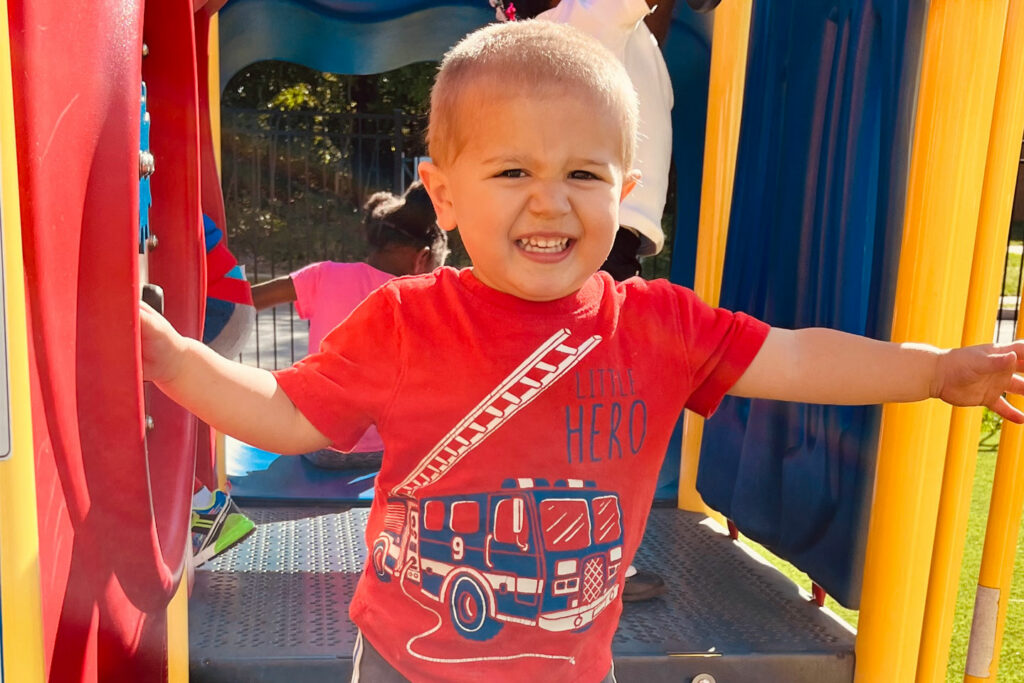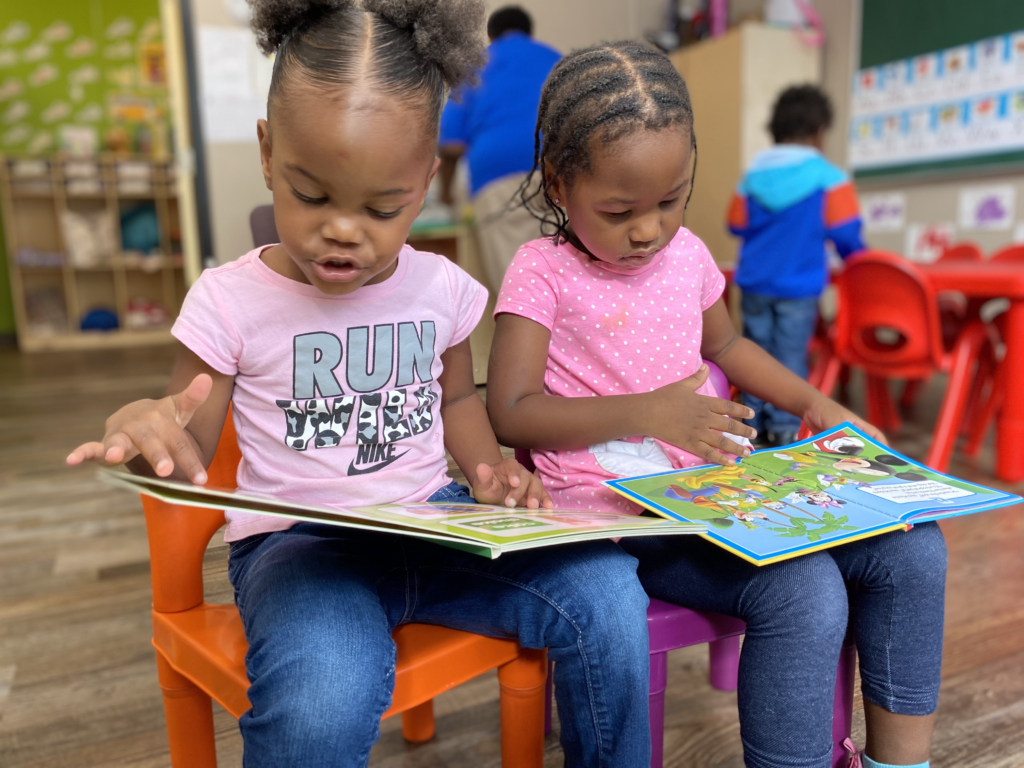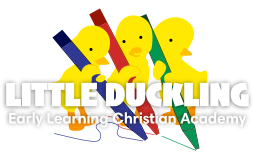Toddlers
The ages of 12 to 24 months bring about a flurry of activity, movement, language, and initial steps of independence as young toddlers continue their growth and learning. Everything is new and exciting, or a bit challenging and frustrating to toddlers. As Little Duckling teaches young toddlers, the “Learning Beyond Paper” curriculum helps by including practical, concrete learning opportunities for young toddlers while giving the teacher the knowledge to know if each child is at their developmental level, requires more opportunities for practice and encouragement, and how a single activity can meet the needs of many young toddlers when teacher expectations are consistent with the child’s age. Learning Beyond focuses on building practical skills, language, social, and emotional learning – all with relationship-focused teaching and care at the heart.


Older toddlers
“I’m 2 now!” From 24 to 36 months, older toddlers show more and more independence when they have opportunities to do things for themselves and have logical consequences. Older toddlers are learning from their behaviors and choices, trying lots of new things, getting messy, and learning how to clean up. The “I” is strong with older toddlers as they begin friendships, strengthen relationships with teachers and other important adults, learn how to talk and communicate in more sophisticated ways, and have many chances to try experiences and activities under the supportive connection with their teachers! Learning Beyond helps educators focus on scaffolding children’s learning, teacher interactions and ways to build children’s knowledge, and giving children choices and options to empower them.
Curriculum goals & objectives
Cognitive and language skills
Demonstrate continual growth in understanding increasingly complex and varied vocabulary
Respond to simple statements, requests, and/or gestures
Use gestures to clarify communication
Use single words or simple phrases
Demonstrate intent of communicating with others
Distinguish words from pictures
Engage in word and sound play with adults
Distinguish between words that contain similar-sounding phonemes
Bring a book to a caregiver to read
Look at books independently
Pretend to read familiar books
Attend to pictures and text for several minutes
Show preference for familiar stores
Respond to simple questions about a story with adult support
Explore drawing, painting, and writing as a way of communicating
Imitate drawing marks or scribbling
Math skills
Imitate verbal counting sequence
Line up or organize objects
Identify numerals as different from letters or other symbols
Identify which is more
Develop the concepts of more and less
Give “all’ objects when asked
Separate a whole quantify of something into parts
Take away objects or combine groups when asked
Attend to a new object in a group of objects
Follow along and imitate patterns of sounds and movement
Clap or move to a beat
Identify attributes of objects with adult support
Combine shapes to make new shapes
Hide behind or between objects for play
Match identical shapes
Follow a daily schedule
Use basic measurement words or gestures to express measurable attributes such as big/little, hot/cold
Social & emotional skills
Identify image of self
Say own name
Show knowledge of own abilities
Communicate feelings and emotions
Express emotion toward a familiar person
Imitate comforting behaviors of caregivers
Use sounds, gestures, and actions to express feelings
Follow simple routines with adult support
Self-soothe with minimal adult support
Demonstrate the beginnings of impulse control with adult support
Imitate how others solve conflicts
Experiment with trial and error approaches to solve simple problems and conflicts
Use social referencing when encountering new experiences
Observe friendship skills in the environments
Approaches to play & learning
Show interest in what others are doing
Select desired objects from several options
Show curiosity/interest in new objects, experiences, and people
Ask questions about familiar objects, people, and experiences
Explore and manipulate familiar objects in the environment
Use objects for real or imagined purposes
Engage and persist with an activity, toy, or object
Scientific thinking
Notice and react to cause and effect within the physical environment
Use tools to explore the physical environment
Begin to identify physical attributes of objects
Imitate the actions of others as they explore objects
Copy patterns and rhythms with objects
Notice and gesture to different objects in the sky
Explore the natural environment
Observe and investigate environment, nature, and climate/weather
Identify living organisms by name
Name basic body parts
Test limits of the environment
Begin to construct and deconstruct using readily available materials
Demonstrate curiosity
Solve problems using trial and error
Social studies
Participate in celebrations and other cultural events if observed
Demonstrate a sense of belonging to a group by engaging in parallel play
Notice differences in others
Use simple words to show recognition of family members and familiar adults
Adapt to changes in routine and/or schedule
Anticipate events
Respond to stories about time and age
Understand and follow basic guidance
Respond to simple location terms
Use a variety of materials to represent familiar objects
Recognize parts of surroundings
Look toward location where familiar objects are stored with the expectation of finding them
Show interest in various aspects of the environment
Communicate desire for objects and/or persons that are in the classroom or home
Imitate familiar roles and routines
Observe others carrying out routines and responsibilities and begin to imitate
Make choices known
Creative arts
Respond to music by moving own body
Imitate sounds using voice or objects
Sing along to familiar songs
Make rhythmic patterns with objects
Use simple art materials
Express preferences for certain art materials
Explore a variety of media
Express likes or dislikes of certain colors or patterns
Look at pictures, photographs, and illustrations
Use objects as symbols for other things
Demonstrate simple character/animal sounds with motions
Physical health & growth
Participate with adult support in health and hygiene-related behaviors
Imitate personal health practices
Demonstrate awareness of danger
Respond to adult direction to change behavior in order to avoid danger or prevent injuries
Express when hungry or full
Try new foods
Feed self with some assistance
Try a new action with a familiar object
Identify basic body parts
Use trial and error to discover how the body and objects move through space
Use simple movement skills to participate in active physical play
Gain control of hands and fingers
Begin to develop coordination and balance, requiring less support
Get in touch to
enroll your child
For more information about our school programs and tuition, or to schedule a tour, fill out the following form. A member of our admissions team will contact you within 24 hours.
Learn more about our:
PROGRAMS
SAFE ENVIRONMENT
TUITION
STAFF
Quick Links
Our Programs
Follow Us
Copyright © 2024 Little Duckling. All Rights Reserved.
Terms | Privacy Policy | Accessibility Policy
